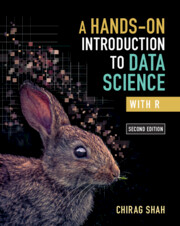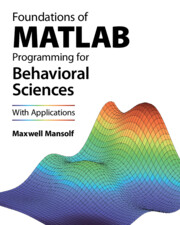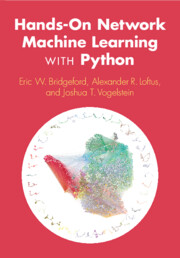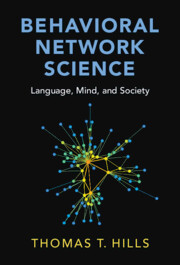Refine search
Actions for selected content:
64 results

A Hands-On Introduction to Data Science with Python
- Coming soon
-
- Expected online publication date:
- January 2026
- Print publication:
- 22 January 2026
-
- Textbook
- Export citation

A Hands-On Introduction to Data Science with R
- Coming soon
-
- Expected online publication date:
- January 2026
- Print publication:
- 22 January 2026
-
- Textbook
- Export citation
Chapter 6 - Using Clinical Data
- from Section 2 - Tools and Methodologies
-
-
- Book:
- Research Methods in Mental Health
- Published online:
- 31 October 2025
- Print publication:
- 20 November 2025, pp 81-94
-
- Chapter
- Export citation

Mathematical Methods in Data Science
- Bridging Theory and Applications with Python
-
- Published online:
- 04 November 2025
- Print publication:
- 30 October 2025
-
- Textbook
- Export citation
Introduction
-
- Book:
- Insight-Driven Problem Solving
- Published online:
- 21 October 2025
- Print publication:
- 30 October 2025, pp 1-11
-
- Chapter
-
- You have access
- HTML
- Export citation
7 - Data Analysis
-
- Book:
- Insight-Driven Problem Solving
- Published online:
- 21 October 2025
- Print publication:
- 30 October 2025, pp 207-249
-
- Chapter
- Export citation
1 - The Big Picture of Analytics Science
-
- Book:
- Insight-Driven Problem Solving
- Published online:
- 21 October 2025
- Print publication:
- 30 October 2025, pp 12-52
-
- Chapter
- Export citation

Foundations of MATLAB Programming for Behavioral Sciences
- With Applications
-
- Published online:
- 28 October 2025
- Print publication:
- 07 August 2025
-
- Textbook
- Export citation
Empowering professionals: An intensive short course on fundamentals of clinical data science
-
- Journal:
- Journal of Clinical and Translational Science / Volume 9 / Issue 1 / 2025
- Published online by Cambridge University Press:
- 10 October 2025, e244
-
- Article
-
- You have access
- Open access
- HTML
- Export citation
Key takeaways from Stanford’s symposium on AI for Data Science
-
- Journal:
- Journal of Clinical and Translational Science / Volume 9 / Issue 1 / 2025
- Published online by Cambridge University Press:
- 25 September 2025, e237
-
- Article
-
- You have access
- Open access
- HTML
- Export citation

Hands-On Network Machine Learning with Python
-
- Published online:
- 23 September 2025
- Print publication:
- 18 September 2025
13 - Data Analysis
- from Part II - Applications of MATLAB Programming in Behavioral Sciences
-
- Book:
- Foundations of MATLAB Programming for Behavioral Sciences
- Published online:
- 28 October 2025
- Print publication:
- 07 August 2025, pp 163-178
-
- Chapter
- Export citation
The pipelines of deep learning-based plant image processing
-
- Journal:
- Quantitative Plant Biology / Volume 6 / 2025
- Published online by Cambridge University Press:
- 25 July 2025, e23
-
- Article
-
- You have access
- Open access
- HTML
- Export citation
A framework for scalable ambient air pollution concentration estimation
-
- Journal:
- Environmental Data Science / Volume 4 / 2025
- Published online by Cambridge University Press:
- 03 March 2025, e17
-
- Article
-
- You have access
- Open access
- HTML
- Export citation
Data science and artificial intelligence in biology, health, and healthcare
-
- Journal:
- Journal of Clinical and Translational Science / Volume 9 / Issue 1 / 2025
- Published online by Cambridge University Press:
- 14 February 2025, e56
-
- Article
-
- You have access
- Open access
- HTML
- Export citation
Chapter 16 - Cultures of Data
-
-
- Book:
- The New Nineteenth-Century American Literary Studies
- Published online:
- 02 January 2025
- Print publication:
- 23 January 2025, pp 233-248
-
- Chapter
- Export citation
The challenge of land in a neural network ocean model
-
- Journal:
- Environmental Data Science / Volume 3 / 2024
- Published online by Cambridge University Press:
- 02 January 2025, e40
-
- Article
-
- You have access
- Open access
- HTML
- Export citation
Understanding to intervene: The codesign of text classifiers with peace practitioners
- Part of
-
- Journal:
- Data & Policy / Volume 6 / 2024
- Published online by Cambridge University Press:
- 27 November 2024, e54
-
- Article
-
- You have access
- Open access
- HTML
- Export citation
Developing a data analytics toolbox for data-driven product planning: a review and survey methodology
-
- Article
-
- You have access
- Open access
- HTML
- Export citation

Behavioral Network Science
- Language, Mind, and Society
-
- Published online:
- 08 November 2024
- Print publication:
- 19 December 2024
